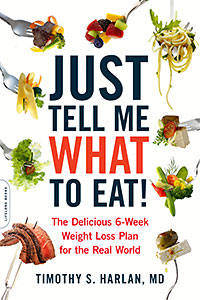More Health and Nutrition Bites
Related
A little movement yields big benefits
The Dr. Gourmet mission is primarily about food and eating healthier, but I can't ignore the impact that exercise can have on your health.
Get your exercise
An international study suggests that more exercise reduces your risk of death - regardless of your weight.
Exercise and Dementia
Just a couple of months ago I told you about a randomized, controlled trial that indicated that omega-3 fatty acid supplements appear to have no effect on the rate of cognitive decline experienced by those over 70.
Health & Nutrition Bites
Get the latest health and diet news - along with what you can do about it - sent to your Inbox once a week. Get Dr. Gourmet's Health and Nutrition Bites sent to you via email. Sign up now!
Sit less, live longer

Heart disease is the leading cause of death in the United States, but the fact is that it's also the most common chronic condition - meaning plenty of people are living with cardiovascular disease. While it's important to look at ways to prevent people from ever developing cardiovascular disease, it's also important to help those living with heart disease manage their risk.
An international team of researchers recently had an article accepted to the British Journal of Nutrition (doi:10.1017/S0007114520002391) that explored diet and physical activity in those living with cardiovascular disease (CVD).
The authors analyzed data gathered from the National Health and Nutrition Examination Survey (NHANES), a large-scale, ongoing prospective study performed in the United States. For their analysis the authors focused on dietary, health, and demographic information gathered between 1999 and 2014, excluding those participants who had not been diagnosed with cardiovascular disease as well as those under 18 years of age and those with incomplete surveys.
Along with dietary and demographic information gathered through regular questionnaires, NHANES also polls its participants regarding physical activity, asking them to estimate the amount of time spent in various types of daily activities at work, during leisure time, and at home. For their analysis the authors focused on those activities considered "sedentary activities", including watching TV, riding in a car or bus, using a computer at home or at the office, reading, doing crafts like knitting, etc.
Almost 2,500 men and women were included in the authors' final analysis, comparing the dietary and activity habits of those who died over the course of the about 5.5 years of analysis with those who did not.
It should be no surprise that compared to those in the lowest third of levels of fiber intake, those in the highest two thirds were about 30% less likely to die of any cause, while their risk of dying of another cardiovascular event dropped by just over 40%. Analyzing the intake of antioxidants such as Vitamins A, C, and E as well as B Vitamins showed that higher intake also reduced risk of death from CVD.
Most significantly, in a dose-response analysis the authors found that those people who spent more than 360 minutes per day in sedentary activities were nearly 40% more likely to die of any cause. Indeed, just 188 minutes spent in sedentary pursuits "resulted in a 20% higher mortality".
The authors analyzed the risks taken together and found that higher fiber and vitamin intakes and less time spent sedentary had an additive effect: risk of all-cause mortality dropped between 35-41% and risk of death from cardiovascular disease dropped between 32-61%.
What this means for you
I reported on this study in people already at greater risk from cardiovascular disease to highlight the importance of spending less time sedentary - which should not be confused with spending more time in vigorous physical activity. The authors in this study grouped sedentary time into three increasing levels: less than 300 minutes sedentary, less than 480 and more than 300 minutes, and 840 or more minutes sedentary.
Take a moment and think about your typical weekday. (Granted, few people can say they have a "typical weekday" these days.) How much time are you spending in the sedentary (mostly seated) pursuits I listed above - and are there ways you can get up and move around a bit more? Could that meeting be done by phone while you take a walk, rather than via zoom as you sit at your desk? Getting a little more activity (or rather, sitting a little less) could have a significant effect on your health.
First posted: July 8, 2020

